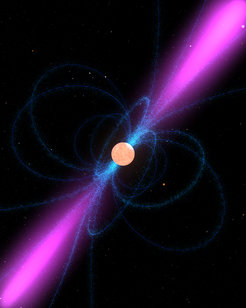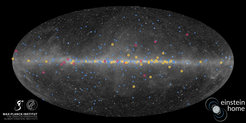Happy 20th birthday, Einstein@Home!
The distributed volunteer computing project was launched on this day in 2005.
Since the launch of Einstein@Home on 19 February 2005, nearly half a million participants from around the world have donated idle computing time on their PCs and smartphones to search for astrophysical signals from spinning neutron stars – small, massive, and exotic remnants of exploded stars. Einstein@Home is one of the world’s largest volunteer computing projects and a scientific success story: It has discovered more than 90 new neutron stars, some of them very unusual, through their radio and gamma-ray pulsations. It is also conducting some of the most sensitive searches for continuous gravitational waves from unknown neutron stars in LIGO data. Finding the elusive waves would provide a new astronomical tool for studying extreme gravity and matter and fundamental physics.
“I had read about SETI@home in 1999 and thought that a distributed volunteer computing project to search for Einstein's gravitational waves would be a great way to involve the public and get more computing power. At the time, it seemed too ‘special interest’ to really work,” says Bruce Allen, director of Einstein@Home and director at the Max Planck Institute for Gravitational Physics in Hannover, Germany. “The idea really took off in 2004, when the American Physical Society, as part of its preparations for the World Year of Physics, offered to help recruit volunteers for our project called Einstein@Home.”
Flagship project
The project was launched on 19 February 2005 by the Max Planck Institute for Gravitational Physics and the University of Wisconsin–Milwaukee as a flagship program of the World Year of Physics, celebrating the centennial of Einstein’s miraculous year. By the end of that year, more than 90,000 volunteers had joined the project and donated computing cycles on their PCs. To date, nearly half a million people have contributed. On average, about 31,000 computers from 16,000 volunteers provide 13.3 petaflop/s (million billion floating point operations per second) of aggregate sustained computing power.
The long-term goal of the project is to detect continuous gravitational waves. Astronomers believe that neutron stars – exotic, compact remnants of exploded massive stars – can produce these tiny ripples in space-time as they spin. Detecting continuous gravitational waves is computationally expensive, and it is only with the help of tens of thousands of volunteers around the world forming a globally distributed supercomputer that the broadest and most sensitive searches become feasible.
The most sensitive search for continuous gravitational waves

“Since we started Einstein@Home our searches for continuous gravitational waves from unknown neutron stars have always been the most sensitive,” explains M. Alessandra Papa, leader of the permanent independent research group “Continuous Gravitational Waves” at the Max Planck Institute for Gravitational Physics in Hannover, Germany. “Thanks to the efficient analysis methods we have developed, we can make the best use of the enormous computing power donated by our volunteers. We are ‘digging deep’ for faint signals hidden in the gravitational-wave data and look forward to more data being released soon to farther our investigations.”
In 2009, Einstein@Home expanded its scope to search for radio pulsars. Like a cosmic lighthouse, this type of neutron star emits regular pulses of radio waves that can be observed with large radio telescopes. In 2008, Bruce Allen met the chair of the PALFA consortium at a conference. The consortium was using the Arecibo radio telescope for a pulsar survey. “We realized that Einstein@Home’s computing power could be put to good use by helping to search for pulsars in binary systems in data from the Arecibo pulsar survey,” says Bruce Allen. “We also knew that it would be many years before we and our volunteers might finally see the first continuous gravitational-wave detection. Finding new, possibly exotic, radio pulsars would keep all of us motivated toward that long-term goal.”
Finding new radio pulsars

Einstein@Home dedicated some of its computing power to a search for radio pulsars in tight binary systems hidden in the Arecibo data. It did not take long for the project to make its first discovery: In the summer of 2010, it found a new radio pulsar in Arecibo data, marking the first astronomical discovery by a distributed volunteer computing project. The pulsar was a rare and unusual type of neutron star, with only a dozen similar examples known at the time. “This was a milestone for us and our volunteers. It proved that citizen science and public participation can make a difference in astronomy and other data-driven sciences,” says Bruce Allen.
Since then, Einstein@Home has also analyzed data from the Murriyang telescope at Parkes Observatory in Australia, the Green Bank Telescope in the USA, and the MeerKAT radio telescope array in South Africa. To date, 55 radio pulsars have been discovered, and there may be many more to come. “Einstein@Home has found radio pulsars in archival data that have been thoroughly analyzed many times before,” says Colin Clark, group leader of the Pulsars group in Allen’s department at the Max Planck Institute for Gravitational Physics in Hannover, Germany. “This is why we expect to find many more exciting radio pulsars with Einstein@Home in the future.”
Gravitational-wave methods discover gamma-ray pulsars
In 2011, Einstein@Home researchers realized that the highly efficient methods they had developed to search for continuous gravitational waves could be put to an entirely new use. Working with colleagues at the Max Planck Institute for Radio Astronomy in Bonn, Germany, they set their sights on analyzing data from the Fermi Gamma-ray Space Telescope. It had become clear that the traditional data analysis methods used to detect the faint gamma-ray pulsations from some neutron stars were too computationally expensive to make new discoveries.
After some successful tests and initial discoveries using the Atlas supercomputer at the Max Planck Institute for Gravitational Physics, the Einstein@Home team ported and optimized the search code to run on tens of thousands of volunteers’ computers. In 2013, they reported the discovery of the first four gamma-ray pulsars found in Fermi data.
Over the next few years, the full discovery potential of Einstein@Home’s analysis of the Fermi Gamma-ray Space Telescope data became clear. Einstein@Home volunteers helped find 39 previously unknown gamma-ray pulsars. This corresponds to about one eighth of all known gamma-ray pulsars.

“One of the great things about the enormous collective computing power of Einstein@Home is that it lets us push the boundaries, and make discoveries that would be otherwise impossible,” says Colin Clark. “We have solved year-old mysteries, found a pulsar hidden in plain sight, the first millisecond pulsar visible only in gamma rays, and a record-breaking ‘spider pulsar’ that evaporates its lightweight companion.”
Distributed computing meets distributed thinking
In 2023, Einstein@Home teamed up with Zooniverse, a successful citizen science web portal. The project “Einstein@Home: Pulsar Seekers” trains volunteers on the Zooniverse platform to identify new pulsars by viewing graphical representations of Einstein@Home search results. More than 3,500 volunteers have already classified almost half a million pulsar candidates. They have identified 16 possible new radio pulsars. “We are now carefully analyzing confirmation observations of the 16 pulsar candidates made with the most sensitive radio telescopes on Earth,” says Bruce Allen. “I expect at least a few of them to be real, and I can’t wait to learn more about the latest discoveries we made thanks to the volunteers.”
Steps towards the first direct detection of continuous gravitational waves
As the gravitational-wave detectors become more sensitive, the Einstein@Home search for continuous gravitational waves gets closer to the first direct observation of these elusive waves. Detecting them could reveal a hidden population of neutron stars in our Milky Way and provide new insights into matter and gravity under extreme conditions. Continuous gravitational waves could also come from clouds of dark matter around spinning black holes, or from orbiting pairs of light (primordial) black holes that formed shortly after the Big Bang.
“I am very excited about the future. The detection of continuous gravitational waves would itself be a major milestone,” says M. Alessandra Papa. “If the continuous waves come from dark matter clouds around black holes or from pairs of primordial black holes, it would have enormous implications for fundamental physics.”














